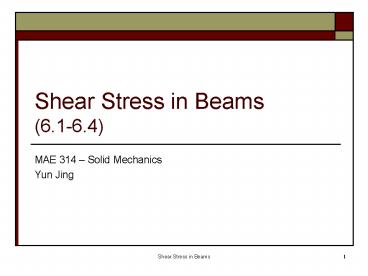Shear Stress in Beams (6.1-6.4) - PowerPoint PPT Presentation
1 / 20
Title:
Shear Stress in Beams (6.1-6.4)
Description:
Shear Stress in Beams (6.1-6.4) MAE 314 Solid Mechanics Yun Jing Shear Stress in Beams * * * * * * * * * * Shear Stress in Beams * Review Previous two chapters ... – PowerPoint PPT presentation
Number of Views:135
Avg rating:3.0/5.0
Title: Shear Stress in Beams (6.1-6.4)
1
Shear Stress in Beams (6.1-6.4)
- MAE 314 Solid Mechanics
- Yun Jing
2
Review
- Previous two chapters only dealt with normal
stresses caused by bending moments. - Chapter 6 deals with shear stress caused by shear
forces.
Line of failure
3
Shear Stress in Beams
- Consider the effects of shear force (V).
- Already know how to find resulting axial force
and moment due to stress sx from Chapter 4. - We have two more equations for shear stress
- Total shear force in the y-direction
- Total shear force in the z-direction
4
Shear Stress in Beams
- Consider a cantilever beam composed of separate
planks clamped at one end - Shear force causes tendency to slide.
- Stresses are equal in horizontal andvertical
directions.
Pure bending
Shear force
5
Shear Stress Horizontal
- Let us consider the horizontal component (tyx
txy). - Cut a section with cross-sectionalarea a at a
distance y1 above thecentroid.
FBD ?
6
Shear Stress Horizontal
- ?H is the horizontal shearing force.
- Element width is ?x.
- Sum forces in x-direction
- Recall from chapter 4
- Solve for ?H and use equation for s
7
Shear Stress Horizontal
- Recall first moment, Q, is defined as
- The term MD-MC can be rewritten as
- Applying this to our equation for ?H
- We can rearrange this to define horizontal shear
per unit length, q, called shear flow.
8
Side Note on Q
- Q is the definition of the first moment for the
area above y1 with respect to the x-axis (see
Appendix A in textbook),where y bar is the
distance between the centroid of the shaded
section and the centroid of beam cross-section.
9
Example Problem
- A beam is made of three planks, 20 by 100 mm in
cross-section, nailed together. Knowing that the
spacing between nails is 25mm and that the
vertical shear in the beam is V 500 N,
determine the shearing force in each nail.
10
Shear Stress Vertical
- Now, let us consider the vertical component (txy
tyx). - We can calculate the average vertical shear
stress on the cross-section.
11
Shear Stress Vertical
- So, where is tAVE maximum and minimum?
- Use Q to find out.
- Q 0 at top and bottom surfaces
- Q maximum somewhere in between
max normal stress
shear stress 0
max shear stress
normal stress 0
max normal stress
shear stress 0
12
Shearing Stress in Common Shapes
- Rectangular cross-section
13
Shearing Stress in Common Shapes
- Beams with flanges
- Vertical shear stresses are larger in the web
than in the flange. - Usually only calculate the values in the web.
- Ignore the effects of the small fillets at the
corners. - Flanges have large horizontal shear stresses,
which we will learn how to calculate later on.
Flange
Web
14
Example Problem
- For the beam and loading shown, consider section
n-n and determine - the shearing stress at (a) point a, (b) point b.
15
Shear Stress in Thin Walled Members (6.7)
- MAE 314 Solid Mechanics
- Yun Jing
16
Shear in Thin Walled Members
- May want to calculate horizontal or vertical
shear stress, depending on the point of interest. - Vertical cut tavg average txz
- Horizontal cut tavg average txy
17
Shear in Thin Walled Members
- Why do we choose to cut the beam perpendicular
to the cross-section wall? - Want to cut across line of shear flow.
Shear flow in box-beam section.
Shear flow in wide-flange beam section.
18
Example Problem
- Knowing that the vertical shear is 50 kips in a
W1068 rolled-steel beam, determine the
horizontal shearing stress in the top flange at
point a
19
Example Problem
- The built-up beam shown is made by gluing
together two 20 x 250 mm - plywood strips and two 50 x 100 mm planks.
Knowing that the allowable - average shearing stress in the glued joints is
350 kPa, determine the - largest permissible vertical shear in the beam.
20
Example Problem
- An extruded aluminum beam has the cross section
shown. Knowing that - the vertical shear in the beam is 150 kN,
determine the shearing stress - a (a) point a, and (b) point b.































